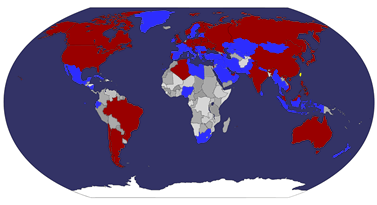National day of the Handicapped People/
Journée Nationale des Personnes Handicapées
National day of the Handicapped People
The number of invalid people knows a constant growth. This category of people constitutes approximately 10% of the population of the world, that is to say the equivalent of 500 million physical and mental handicapped people.
Arab Le Monde account an average of 15% people handicapped on her population. In Algeria, the National office of the Statistics counts 1,8 million invalids.
Following the example valid people, the Algerian State made the required efforts for the assumption of responsibility of the people handicapped in their guaranteeing all the average materials and financial allowing them to be integrated on the plans professional and social, and to fit fully and effectively in the process of the national development.
Thus, this category of people did not cease occupying the place which returns to him while being essential in particular in the field of the sport. Indeed, Algerian selection of the handisport fur the best ambassador who, through his multiple achievements, could represent with dignity and honourably Algeria at the time of the various international sporting events.
Following her participation in the Olympic Games organized in 2004 in Athens (Greece), the Algerian team of the handisport collected a total of 13 medals including 6 gold medals, 2 money medals and 5 bronze medals.
It was not only success since, four years later, at the time of the plays of the 29th Olympiad which sheltered the Chinese capital, Beijing, the Algerian athletes of the category in question were also crowned by a total of 15 medals among which 4 gold medals appear, 3 money medals and 8 bronze medals.
The merit of the creation of the handisport in be allocated to the English doctor and professor, Ludwig Guttman, which organized on July 22, 1948 in the United Kingdom, first plays of the handisport. Nowadays, paralympic the account 23 plays officially recognized of which 19 plays of summer and 4 plays of winter, adapted to the various types of handicap.
Algeria proclaimed dated March 14 each year “national day of the handicapped people”. The commemoration of this day comes to confirm the dedication of the principle relating to the protection and the promotion of the handicapped people.
The celebration of the national day of the people handicapped aims promoting a better comprehension of the problems involved in handicaps and at mobilizing all energies in order to ensure the respect of dignity, the rights and the good being of the handicapped people.
Journée Nationale des Personnes Handicapées Le nombre de personnes invalides connaît une constante croissance. Cette catégorie de personnes constitue environ 10% de la population du monde, soit l'équivalent de 500 millions d'handicapés physiques et mentaux. Le Monde Arabe compte une moyenne de 15 % de personnes handicapées sur sa population. En Algérie, l'Office Nationale des Statistiques recense 1,8 million de d'invalides. A l'instar des personnes valides, l'Etat Algérien a déployé les efforts nécessaires pour la prise en charge des personnes handicapées en leur garantissant tous les moyens matériels et financiers leur permettant de s'intégrer sur les plans professionnel et social, et de S'inscrire pleinement et efficacement dans le processus du développement national. Ainsi, cette catégorie de personnes n'a pas cessé d'occuper la place qui lui revient en s'imposant notamment dans le domaine du sport. En effet, la sélection algérienne de l'handisport fur le meilleur ambassadeur qui, à travers ses multiples réalisations, a pu représenter dignement et honorablement l'Algérie lors des différentes manifestations sportives internationales. Suite à sa participation aux Jeux Olympiques organisés en 2004 à Athènes (Grèce), l'équipe algérienne de l'handisport a récolté un total de 13 médailles dont 6 médailles d'or, 2 médailles d'argent et 5 médailles de bronze. Ce ne fut pas le seul succès puisque, quatre ans plus tard, lors des jeux de la 29ème olympiade qu'a abrité la capitale chinoise, Pékin, les athlètes algériens de la catégorie en question ont été également couronnés par un total de 15 médailles parmi lesquelles figurent 4 médailles d'or, 3 médailles d'argent et 8 médailles de bronze. Le mérite de la création de l'handisport en revient au médecin et professeur anglais, Ludwig Guttman, qui a organisé le 22 juillet 1948 en Grande Bretagne, les premiers jeux de l'handisport. De nos jours, les paralympiques compte 23 jeux reconnus officiellement dont 19 jeux d'été et 4 jeux d'hiver, adaptés aux différents types d'handicapes. L'Algérie a proclamé la date du 14 Mars de chaque année « journée nationale des personnes handicapées ». La commémoration de cette journée vient confirmer la consécration du principe relatif à la protection et à la promotion des personnes handicapées. La célébration de la journée nationale des personnes handicapés vise à promouvoir une meilleure compréhension des problèmes liés à l'handicape et à mobiliser toutes les énergies afin d'assurer le respect de la dignité, des droits et du bien être des personnes handicapées.



















































































 taiwan
taiwan  cover or postcard
cover or postcard  FDC
FDC 





























































































